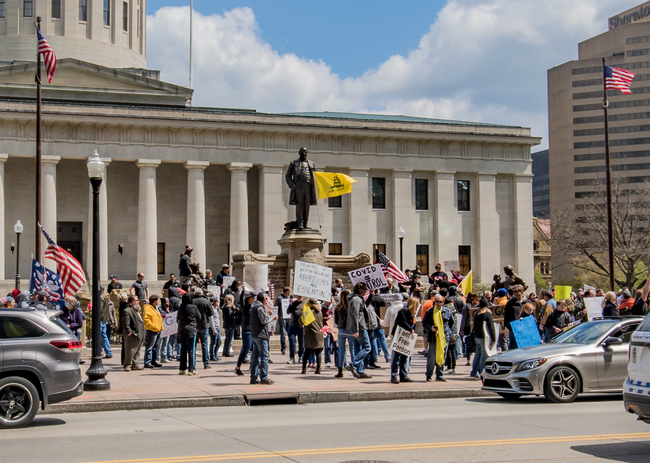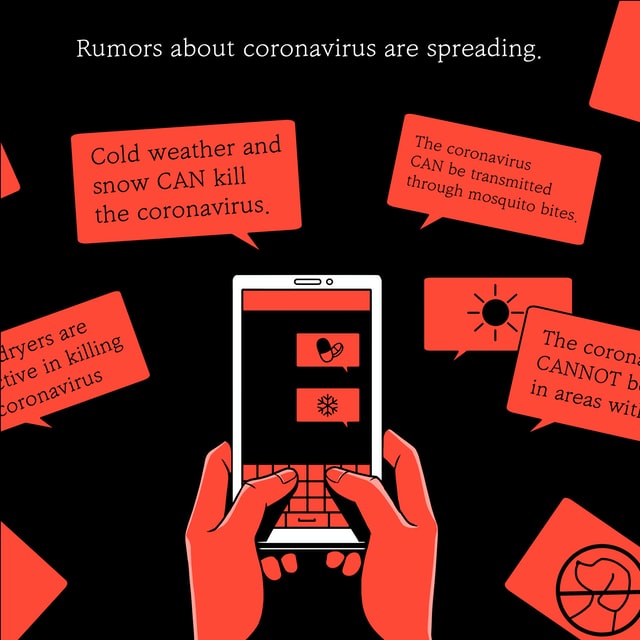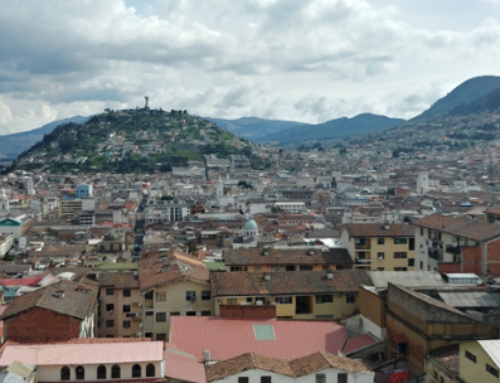Conspiracies surrounding the Covid-19 pandemic are not unique or “new” in how they mobilize and rally against government institutions, science, and both “democrats” and “liberals.” In my research about conspiracy theories and the radical right, I’ve argued that the pandemic and various lockdowns around the world wouldn’t necessarily create a “new” wave of extremists, but would rather play to pre-existing conspiratorial beliefs and further radicalize rather than cause radicalization (DeCook 2020a; 2020b). All over the world, and particularly in the United States, the anti-science, anti-intellectualist, and anti-establishment ideologies which fuel these movements have been long ongoing. We are merely seeing the outcomes of a long-fought culture war rather than witnessing its beginnings. Add the recent protests that have erupted across the country against the murders of George Floyd, Breonna Taylor, and Ahmaud Arbery, fueled by centuries of racism and social inequity faced by Black Americans, and we are seeing alternative epistemologies in the form of conspiracy theories emerge en masse.
In the current situation, disinformation and conspiracy theories are being pushed from people all along the political spectrum – in times of chaos, everybody regardless of political beliefs is grasping for a nugget of truth to make sense of the situation. Even if the information isn’t true, it serves some kind of need for our anxious brains to quell uncertainty. In the current digital age, however, information – including conspiracy theories – travel at speeds that make it almost impossible to correct information or to control the spread of dangerous misinformation and conspiracy theories. As one headline put it, “misinformation spreads faster than the coronavirus,” (Ashoka 2020) and more alarmingly, research has shown that misinformation spreads faster than factual information (Vosoughi, Roy, and Aral 2018). We are in the midst in an ever-evolving infodemic, one that was inevitable with the use of digital platforms in spreading disinformation and these massive social media companies doing little to nothing to quell its spread (Zadrozny 2020). It was recently found that “troll farms,” as they’re colloquially called, in Macedonia and other countries that spread large amounts of disinformation during the 2015 primaries and 2016 election were also spreading Covid-19 disinformation (Collins and Zadrozny 2020), meant to confuse the public, undermine government policies, and take advantage of a time of chaos by exploiting the affordances of these technologies.

People gathered to protest against Covid-19 lockdowns claiming (amongst other things) that the virus is a Democrat hoax. “Columbus coronavirus protests at the Ohio Statehouse, 2020-04-18” by Ɱ. Licensed under CC BY-SA 4.0. To view a copy of this license, visit https://creativecommons.org/licenses/by-sa/4.0
But placing the blame on nefarious outside actors obscures the ways in which the average person adheres to and believes in conspiracy theories. These alternative epistemologies are quickly gaining traction due to responses to the pandemic and the recent protests, and the speed at which information changes, ideologies evolve, and how they spread is dizzying and adds to the uncertainty of our current sociohistorical moment – uncertainty that creates anxiety, which then implores people to seek out more and more information to mitigate their fear. Paul Virilio, the late French philosopher, famously said that his philosophy was one that considered speed as the main engine of destruction (Virilio 2006), made possible through the militarization of society. If we understand affordances not to be just merely possible uses of a technology, but rather possibilities of action (Nagy and Neff 2015), the term takes on a new dimension and meaning.
We are now in the age of information warfare, made possible by the very structure and logic of militarized technology itself. Combined with the nature of conspiracy theories we’ve created the perfect toxic combination for the vehicle of radicalization. Conspiracy theories must not be considered to be beliefs or ideas that are fundamentally untrue, or that they are reflective of an epistemic deficit (Pauly 2020). Stef Aupers has argued that conspiracy theories and paranoia are embedded in the cultural logic of modernity – conspiracy culture is not a fringe phenomenon but rather has been absorbed into the mainstream (Aupers 2012). Their influence, wide ranging spread due to digital technologies, and continual evolution position conspiracy theories as adaptive epistemologies that are having real and dangerous consequences on societies around the world, ranging from public health crises in the form of anti-vaccination movements and people not believing in the severity of Covid-19, dissolving democracies in the case of countries like the USA, the UK, Brazil, and the Philippines (and many more), and even genocide in the case of the Rohingya in Myanmar. In the context of the current pandemic, conspiracy theories about Covid-19 have resulted in people being aggressive and violent toward workers who ask them to wear masks, armed protestors storming state capitol buildings demanding that shelter-in-place orders be lifted, and for a neo-Nazi accelerationists planning to bomb hospitals (Williams 2020). In all these examples, the issue of what is truth and more importantly, what is reality and how is it shaped, and how truth and reality are shaped and mediated are at the forefront.
More specifically, what we are currently witnessing is not a debate of whether or not truth “exists,” (i.e. is there just one, singular, all-encompassing truth) but rather who is shaping the truth and to what ends we understand the concept of truth in and of itself (Jurgenson 2018). Rather than focusing on the “truthfulness” of conspiracy theories, using concepts like René Girard’s scapegoat mechanism (among others) (Andrade n.d.) may help us make more sense of the ontological and epistemological groundings of conspiracy theories. Conspiracy theories fundamentally depend on the identification of a group of nefarious actors, most often government and other institutional actors, who are trying to undermine the very fabric of society. This target, however, can often be a sliding signifier – conspiracy theories range from blaming Jewish people (aka “globalists”) (Zimmer 2018) for the collapse of society to vast networks of child traffickers (Johnson 2018); and that by exposing and in the most extreme cases, eliminating these scapegoats order will be restored. In the era of Covid-19, these scapegoats have been the Chinese Communist Party (and by extension, racism and hate crimes against Asians has increased), the “globalists” and Jewish people, (for instance, in the Arab world there was a conspiracy theory spreading that Israel had created the virus), and in the United States, the scapegoat for conservatives and the far right are liberals and democrats, whom they believe “created” the Covid-19 crisis to prevent Donald Trump from being re-elected (Ball and Maxmen 2020). Regardless of who or what the scapegoat is, however, the mechanisms used to evolve their arguments remain consistent – the creation and sharing of information and other narratives in various forms.
Stories We Tell Ourselves: Covid Conspiracies
Per Walter Benjamin, information and stories are not one in the same (Benjamin 1969). The sharing of information is not the same as the sharing of stories that fundamentally are the makeup of our identities and our understandings of the self (Bruner 2004). Thus, to truly understand a conspiracy theory, we can’t just look at the bits of information that are pieced together to try to provide evidence or proof, but rather look at its story and its narrative components. These narrative pieces, then, help to explain and reveal the logical connections being made and also how these narratives can be absorbed as a part of a larger identity for the conspiracy theorist.
Unpacking radical right conspiracies, for example, requires an examination of coded symbols and language and the historiography of the beliefs – close readings of far-right beliefs reveal the ways in which intertextuality is used across borders to advance ideas of a singular and abstract “Western civilization” and of conceptions of whiteness and belonging. If language is dialogic, then stories and their resulting discourse are in constant communication with one another as well (Bakhtin 1983). In the current digital age, borders and time/space have been collapsed, meaning that discourses travel, change, and adapt more quickly. It is within this shift in sharing of discourses that we see debates over the nature of truth and reality itself – but the question isn’t about the singular truth in defining reality, but about whose and what kinds of truths that these narratives build and strengthen (Seargeant 2019). With the addition of the mainstream media and online platforms, this analysis of the frames and narratives being told about events becomes even more crucial in our understanding of reality; in particular when we consider their intertextual and dialogic components in how these narratives are structured.

Conspiracy theories often reveal something about the underlying anxieties and fears of the sociohistorical period they are created in as well as the personal anxieties of the adherents themselves. These narratives are the very things that lay the foundation for the far-right imaginary, helping to give them a sense of group identity but also have a mythological component in giving their movement history and purpose. For instance, in the case of Covid-19, increasing hate crimes against Asians are merely incarnations of the “yellow peril” fears long held by Westerners (Kawai 2005) and the long-held fear of the Other and disease (Markel and Stern 2002). Conspiracies that 5G technology (specially, the invisible “waves” that make it possible) are what is causing the illness and not a virus, as well as the conspiracy theory that the crisis will be used to justify implanting microchips in people (by Bill Gates, nonetheless), and fears of mandatory vaccination being used to control them are reflective of the ever-evolving fears of technology and of bodily invasion long held by humans with every new technological and medical development (Romm 2015). The reopen protests in April reflect a population of white men (many of whom are 3%ers and Second Amendment enthusiasts) who cling to the idea of the white masculine patriot hero, whose masculinity and freedom are under constant threat by women, Jews, and minorities (Kimmel 2017). And a recently emerging movement calling themselves the Boogaloo Bois are using the movement to call for their goal of bringing about a race war and second civil war – although they initially started appearing on forums like 4chan sometime in 2019, the pandemic in conjunction with the protests has given them the opportunity and social unrest for them to try and mobilize (Owen 2020).
With the current protests in the United States, the conspiracy theories and fears that form people’s narrative constructions of their identities are being adapted once again – which is a pattern we’ve seen throughout history (Neklason 2020). By tapping into existing fears and paranoid beliefs, conspiracy theories are the engine driving the train of the far-right imagination. But if conspiracy theories are a part of the mainstream, scholars, policymakers, and the general public must reckon with the notion that there is no longer something “alternative” about the alt-right or “far” of the far right – rather, they have managed to mainstream their paranoia through these affective networks (Johnson 2018; Sundén and Paasonen 2018). The stories they tell themselves, and to one another, about the nature of the world and the possibility of a white genocide, the threat to their guns and personal liberties, and the decline of Western civilization are all used to advance an agenda that aims to reclaim their power in a world they believe is increasingly no longer acting in their best interest. Thus, these beliefs are not all about fear, but rather about the desire to reclaim power and to “right” the wrongs that they see before them. Taking advantage of the possibilities present in chaos (Wilson 2020), the radical right is conscious in their choice of actions, words, and narratives that they use to further their goals. And during the current crises, health and civil, these narratives are being used to provide evidence for the validity of their paranoia. These affects then spread across networks, strengthening and mobilizing the far right and their influence. The persistent dominance of far-right beliefs and conspiracy theories, and the violence they perpetuate, are not bugs in the system, but rather a feature and a part of its very architecture (Noble 2018; Daniels 2018).
References:
Andrade, Gabriel. n.d. “Girard, Rene.” Internet Encyclopedia of Philosophy. n.d. https://www.iep.utm.edu/girard/.
Ashoka. 2020. “Misinformation Spreads Faster Than Coronavirus: How A Social Organization In Turkey Is Fighting Fake News.” Forbes. 2020. https://www.forbes.com/sites/ashoka/2020/04/17/misinformation-spreads-faster-than-coronavirus-how-a-social-organization-in-turkey-is-fighting-fake-news/#30ae988e417d.
Aupers, Stef. 2012. “‘Trust No One’: Modernization, Paranoia and Conspiracy Culture.” European Journal of Communication 27 (1): 22–34.
Bakhtin, M. M. 1983. The Dialogic Imagination: Four Essays. Edited by Michael Holquist. Translated by Caryl Emerson. Reprint edition. Austin, Tex: University of Texas Press.
Ball, Philip, and Amy Maxmen. 2020. “The Epic Battle against Coronavirus Misinformation and Conspiracy Theories.” Nature 581 (7809): 371–74. https://doi.org/10.1038/d41586-020-01452-z.
Benjamin, Walter. 1969. Illuminations. Vol. 241. 2. Random House Digital, Inc.
Bruner, Jerome. 2004. “The Narrative Creation of Self.” In The Handbook of Narrative and Psychotherapy: Practice, Theory, and Research, edited by L.E. Angus and J. McLeod, 3–14. SAGE Publications, Inc.
Collins, Ben, and Brandy Zadrozny. 2020. “Troll Farms from North Macedonia and the Philippines Pushed Coronavirus Disinformation on Facebook.” NBC News. 2020. https://www.nbcnews.com/tech/tech-news/troll-farms-macedonia-philippines-pushed-coronavirus-disinformation-facebook-n1218376.
Daniels, Jessie. 2018. “The Algorithmic Rise of the ‘Alt-Right.’” Contexts 17 (1): 60–65. https://doi.org/10.1177/1536504218766547.
DeCook, Julia R. 2020a. “Coronavirus and the Radical Right: Conspiracy, Disinformation, and Xenophobia.” OpenDemocracy. 2020. https://www.opendemocracy.net/en/countering-radical-right/coronavirus-and-radical-right-conspiracy-disinformation-and-xenophobia/.
———. 2020b. “Quarantined Radicals: Right-Wing Extremism In The Age Of COVID-19.” Rantt Media (blog). April 16, 2020. https://rantt.com/quarantined-radicals-right-wing-extremism-in-the-age-of-covid-19.
Johnson, Jessica. 2018. “The Self-Radicalization of White Men: ‘Fake News’ and the Affective Networking of Paranoia.” Communication, Culture and Critique 11 (1): 100–115. https://doi.org/10.1093/ccc/tcx014.
Jurgenson, Nathan. 2018. “Faked Out.” Real Life, 2018. https://reallifemag.com/faked-out/.
Kawai, Yuko. 2005. “Stereotyping Asian Americans: The Dialectic of the Model Minority and the Yellow Peril.” The Howard Journal of Communications 16 (2): 109–130.
Kimmel, Michael. 2017. Angry White Men: American Masculinity at the End of an Era. Revised edition. New York: Nation Books.
Markel, Howard, and Alexandra Minna Stern. 2002. “The Foreignness of Germs: The Persistent Association of Immigrants and Disease in American Society.” The Milbank Quarterly 80 (4): 757–88. https://doi.org/10.1111/1468-0009.00030.
Nagy, Peter, and Gina Neff. 2015. “Imagined Affordance: Reconstructing a Keyword for Communication Theory.” Social Media+ Society 1 (2): 2056305115603385.
Neklason, Annika. 2020. “The Conspiracy Theories That Fueled the Civil War.” The Atlantic, 2020. https://www.theatlantic.com/politics/archive/2020/05/conspiracy-theories-civil-war/612283/?utm_source=twitter&utm_content=edit-promo&utm_term=2020-05-29T22%252525253A25%252525253A13&utm_medium=social&utm_campaign=the-atlantic.
Noble, Safiya Umoja. 2018. Algorithms of Oppression: How Search Engines Reinforce Racism. New York: NYU Press.
Owen, Tess. 2020. “Far-Right Extremists Are Hoping to Turn the George Floyd Protests Into a New Civil War.” Vice (blog). May 29, 2020. https://www.vice.com/en_ca/article/pkyb9b/far-right-extremists-are-hoping-to-turn-the-george-floyd-protests-into-a-new-civil-war.
Pauly, Marc. 2020. “Conspiracy Theories | Internet Encyclopedia of Philosophy.” Internet Encyclopedia of Philosophy. 2020. https://www.iep.utm.edu/conspira/.
Romm, Cari. 2015. “Americans Are More Afraid of Robots Than Death.” The Atlantic. October 16, 2015. https://www.theatlantic.com/technology/archive/2015/10/americans-are-more-afraid-of-robots-than-death/410929/.
Seargeant, Philip. 2019. “What Conspiracy Theories Have in Common with Fiction – and Why It Makes Them Compelling Stories.” The Conversation. 2019. http://theconversation.com/what-conspiracy-theories-have-in-common-with-fiction-and-why-it-makes-them-compelling-stories-128046.
Sundén, Jenny, and Susanna Paasonen. 2018. “Shameless Hags and Tolerance Whores: Feminist Resistance and the Affective Circuits of Online Hate.” Feminist Media Studies 18 (4): 643–56. https://doi.org/10.1080/14680777.2018.1447427.
Virilio, Paul. 2006. Speed and Politics. Translated by Mark Polizzotti and Benjamin H. Bratton. New York: Semiotext.
Vosoughi, Soroush, Deb Roy, and Sinan Aral. 2018. “The Spread of True and False News Online.” Science 359 (6380): 1146–1151.
Williams, Pete. 2020. “Man Planned to Bomb Hospital during Pandemic to Get Attention for White Supremacist Views.” NBC News. 2020. https://www.nbcnews.com/news/us-news/missouri-man-planned-bomb-hospital-during-pandemic-get-attention-white-n1172346.
Wilson, Jason. 2020. “Disinformation and Scapegoating: How America’s Far Right Is Responding to Coronavirus.” The Guardian, March 19, 2020, sec. World news. https://www.theguardian.com/world/2020/mar/19/america-far-right-coronavirus-outbreak-trump-alex-jones.
Zadrozny, Brandy. 2020. “They’re on the Misinformation Front Line. Here’s What They Predict about the Virus.” NBC News. 2020. https://www.nbcnews.com/tech/social-media/these-disinformation-researchers-saw-coronavirus-infodemic-coming-n1206911.
Zimmer, Ben. 2018. “The Origins of the ‘Globalist’ Slur.” The Atlantic. March 14, 2018. https://www.theatlantic.com/politics/archive/2018/03/the-origins-of-the-globalist-slur/555479/.
Cite As: DeCook, Julia R. 2020. “The Culture of Conspiracy and the Radical Right Imaginary” In “Pandemic Diaries,” Gabriela Manley, Bryan M. Dougan, and Carole McGranahan, eds., American Ethnologist website, 15 June 2020 [https://americanethnologist.org/features/pandemic-diaries/making-sense-of-things/the-culture-of-conspiracy-and-the-radical-right-imaginary]
Julia R. DeCook is an Assistant Professor of Advocacy and Social Change in the School of Communication at Loyola University Chicago. Her twitter handle is @julesopolis.




